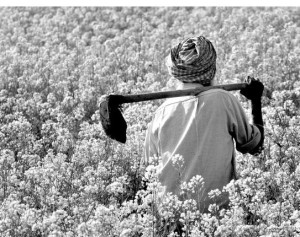
WTO inspectors should stay clear of our food policies. – Akhilesh Kumar
Commerce Minister Anand Sharma managed to wrest some elbow room for India’s food subsidy programme, bringing around the US and other developed countries to accept his point of view.
The agreement finalised at the Ninth WTO Ministerial in Bali is expected to let the ‘peace clause’ — a euphemism for not taking any action for supposedly violating commitments under the Agreement on Agriculture (AoA) — continue till a permanent solution comes into being.
Developed countries (DCs) wanted this window to be only for four years, without even drawing a time line for a lasting solution. They were merely willing to discuss it at the next Ministerial in 2017.
Sharma exudes confidence that subsidy under Food Security Act (FSA) is now fully shielded against challenge at WTO even if it exceeds 10 per cent of agricultural GDP.
His exuberance is misleading. By just accepting the ‘peace clause’, India has given a signal that it is likely to commit a violation.
The point that Sharma has missed is that there is no question of our violating WTO norms.
Right computation
Under FSA, Government ‘guarantees’ supply of 5 kg of cereals per person per month at Rs 3 per kg rice, Rs 2 per kg wheat and Re 1 per kg coarse cereals to 67 per cent of the population.
Selling food grain at a price below cost of supply is tantamount to subsidising consumers of foodgrain. This is not a support to producers and cannot be appended to the subsidy (amber box) that comes under AoA.
Such a subsidy serves an overriding food security objective and is covered in Annexure 2 of AoA. This subsidy is exempt from reduction commitments.
The Annexure says that such programmes “shall not have effect of providing price support to producers”. We need to pinpoint this component, instead of abiding by the general view that the entire subsidy under FSA as ‘trade distorting’. Our negotiators have simply not bothered!
In WTO parlance, subsidy or AMS (aggregate measure of support) has two components: (i) product-specific and (ii) non-product specific. The first is the excess of price paid to farmers over ‘external reference price’ (ERP) multiplied by the quantum of produce.
The second is subsidy on inputs viz., fertilisers, seed, irrigation, electricity.
For computing ‘product-specific’ subsidy, AoA takes ERP as in 1986-88. This is illogical. For determining subsidy to domestic farmers, say, in 2013-14, how can one compare current minimum support price (MSP) with ERP of 25 years ago?
At present, Indian farmers get $225 per tonne for wheat against a global price of $300 per tonne. They are ‘negatively’ subsidised to the extent of $75 per tonne.
If ERP in 1986-88 of $150 per tonne is used, our farmer would deem to be getting subsidy of $75!
Our strategists have glossed over this flaw which results in a gross over-estimation of subsidy. We end up being seen as violating WTO commitments.
Article 6.2 of AoA exempts resource-poor farmers. During the Uruguay Round, India had submitted that input subsidies given to 79.5 per cent of total land holdings (farmers with less than 10 hectares) fall in this category. This, too, helps in trimming the subsidy under WTO’s lens.
Then there is Article 18.4 that allows for possibility of addressing concerns of countries that suffer from ‘excessive inflationary’ pressures. This provides yet another buffer.
Therefore, the right way is: Take the ‘current’ ERP in computation of product-specific subsidy; exclude subsidy to consumers under FSA (ERP minus price paid by them Rs 1/2/3 per kg); exclude subsidy to 79.5 per cent of resource poor farmers (Article 6.2) and capture additional buffer of Article 18.4.
The resultant AMS would be well within 10 per cent of value of agricultural production.
Collateral damage
True, our Commerce Minister has persuaded WTO to set aside punitive action. But that is a defensive approach; it projects India as a violator and would make us vulnerable all through the process of negotiations.
Moreover, India could still come under pressure. At every stage, India will have to demonstrate that our regime does not distort trade or hamper food security of another country.
We would also suffer a collateral damage of subjecting our entire food security system to surveillance. Like a convict, every action of India — procurement, stocking, distribution, subsidy, when it breaches the so-called 10 per cent — would be watched.
However, this does not mean that public management of food stocks and the issue of input subsidies are not a cause for concern. Already, food stocks are more than twice the quantity needed. Further, governments are competing with each other in raising MSPs.
Long pending reforms in regard to fertiliser subsidy are on the backburner. Even reform measures already taken have been over-turned. Direct benefit transfer (DBT) for fertilisers and food has remained on paper.
Under AoA, de minimis (limit) for developed countries was 5 per cent of farm GDP.
Despite actual subsidy for OECD countries in 1986-88 being 52 per cent, the reduction commitment was kept at a mere 20 per cent over five years. Post-cut, the support would still be 42 per cent of farm GDP!
The developed countries did not honour even this token commitment. From 52 per cent in 1986, AMS was lowered to 42 per cent in 1997 only to be raised to 55 per cent by 1999.
India needs to goad developed countries not to breach the 5 per cent mark. It should talk from a position of strength.
India’s farm subsidies are well within WTO limits. The Government can talk from a position of strength.
Published at http://www.thehindubusinessline.com/todays-paper/tp-opinion/no-reason-to-fear-wto-on-farm-subsidy/article5441978.ece